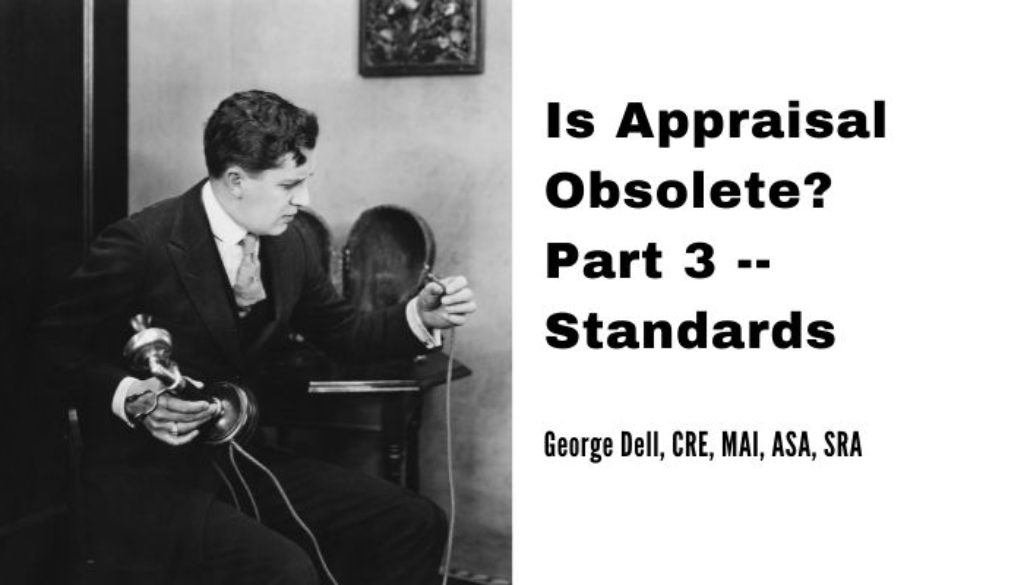Obsolete — Standards?! This is third in a series, as we look at this question from the viewpoints five forces of friction: process, standards, education, client expectation, and regulation.
This issue is about valuation standards. We will end with part 7: the mystery solution.
In the United States, the predominant standards are USPAP (Uniform Standards of Professional Appraisal Practice). USPAP is published by the non-profit Appraisal Foundation. Although the foundation sets itself out as “the nation’s foremost authority on the valuation profession” – it competes with other industry, government, professional, and international standards. In specific, these appraisal standards only apply to valuations done by appraiser opinion.
“USPAP does not establish who or which assignments must comply.” It does not make law.
The requirement to comply is enforced via complex, convoluted ‘dotted line’ relationships with financial institutions, states, and government agencies – including appraiser licensing complexities.
The Foundation enjoys exclusive government subsidies (via the “Appraisal Subcommittee”), appraiser fees, approval fees, exclusive publishing rights, and ‘required’ education. These standards focus on the appraiser, rather than valuation process or results. The value result is a personal, professional opinion.
The stated, required goal of an opinion appraiser is believability. The definition of this goal is for the appraiser to be credible. Credible is defined as “worthy of belief.” Similarly, an appraisal reviewer’s goal is to provide a worthy opinion, of the worthiness of the opinion of the original appraiser. (And similarly, a review of a review is also judged on the credible worthiness of its worthiness opinion). The word ‘credible’ is used 276 times in the most recent version of the USPAP publication – the updated version extended with negligible changes to the year 2022.
USPAP focus is on credibility — not reliability nor usefulness. Therein flies the problem.
The standards were well purposed in those days. Data was paper-based, in the file drawers of county recorders and real estate brokers (MLS quarterly books), buyers, and sellers. Good judgment and believable opinion were paramount. Analytic results and probability estimates were not possible.
Today, calculated results, accompanied by risk/reliability estimates are possible.
The restated modern question then might be: Is USPAP useful in a world of complete immediate data, and transparent analyses?
“Personal credibility” is not useful where society needs measurable risk and auditable process.
ON THE OTHER HAND . . .
USPAP does provide some excellent, forward-looking guidance. Guidance missing from traditional appraisal process (part 2 of this series). This is the traditional and ‘accepted’ “body of knowledge” doctrine. – That data selection via judgment and a belief-based process is the best model.
I keep reading and re-reading the USPAP Standards Rule 1-4. I simply do not find where it says an appraiser should use the “best” three or six comps.
What this standard does say is: proper selection of “all information” is necessary for credible results. And requires the use of “such comparable sales data as are available.” The use of partial information appears to be a “violation” of USPAP. It also injects analytic bias. Albeit, not necessarily personal bias.
Appraisal professionals, users, regulators; together have fallen into an expectation/acceptability trap. Acceptability contrary to the core of factual, objective data selection, and rational reason. Groupthink.

December 15, 2021 @ 6:39 am
Mr. Dell, for the past few years I thought USPAP was obsolete but am no longer certain. One of my concerns was that public trust is the goal of USPAP but that there is no measure of trust, no metric with which to gauge appraiser performance. The variance between appraisals on the same property can be so great that how could the public trust opinions that vary so much? Why would they place any more faith in an appraiser than say a real estate agent? Collateral Underwriter and the UCDP now allow the GSEs to measure and track the variance between appraisals of like properties, differences from contract price and other data. This raised the concern that big data would be more consistent and would eat away at appraiser market share of valuations.
That said, appraisers still have one tool that the AVMs will never possess: judgement. We have the judgement to recognize when something is off: an adverse influence, mismatched finishes, substandard construction, condition, quality and more. AVMs and big data will only be as good as the algorithms written for them. Appraisers are market experts, constantly assessing and reassessing markets and searching for patterns in buyer behavior. AVMs only know to look for what they were programmed to look for.
The recent failure of Zillow’s house flipping business highlighted the weakness of AVMs. Somehow their model lost money during this real estate boom, highlighting the limitations of the big data approach to valuation. So, at least for now, USPAP and the old-school, judgement-based valuations appear to be holding up.
December 15, 2021 @ 8:51 am
Thank you for your well-thought-out comments.
Yes, I do believe expert judgment is a critical part of the optimal system.
Neither automated algorithms, nor ‘believability’ alone are adequate.
Modern tools and refined models are available. New skills are needed.
If the profession does not provide the education, someone else will.